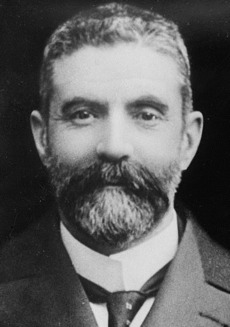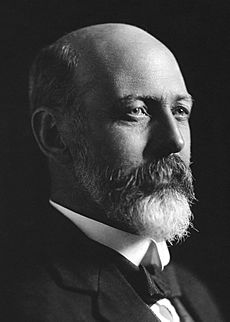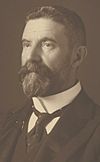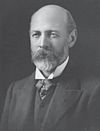Liberal Party (Australia, 1909) facts for kids
Quick facts for kids
Liberal Party
|
|
|---|---|
| Leader |
|
| Founders |
|
| Founded | 25–27 May 1909 |
| Dissolved | February 1917 |
| Merger of | |
| Merged into | Nationalist |
| Ideology |
|
| National affiliation | Liberal Union |
The Liberal Party was an important political group in Australia from 1909 to 1917. It was created when two other parties, the Protectionist Party and the Anti-Socialist Party, joined together. This event was often called the Fusion. Alfred Deakin was the first leader of this new party.
Before the Liberal Party, Australia's government was often unstable. Many different parties tried to work together, but it was hard to form a strong government. The creation of the Liberal Party helped create a more stable system, where two main groups competed for power.
The Liberal Party formed Australia's first federal government that had a clear majority of seats. This allowed Alfred Deakin to become prime minister for a third time. However, the party lost the next election in 1910. They didn't win many elections after that.
In 1916, the Australian Labor Party (ALP) split over the issue of conscription (forcing people to join the army). Joseph Cook, who took over from Deakin, led the Liberals to join forces with Prime Minister Billy Hughes' new group, the National Labor Party. These two parties officially merged in 1917. They formed the Nationalist Party, which became the main rival to the ALP.
Unlike the Labor Party, the Liberal Party didn't have a big national organisation outside of parliament. They had loose connections with similar parties in each state. Deakin tried to create a national group called the "Commonwealth Liberal Party," but it mostly stayed in Victoria. Different groups in each state helped choose candidates and raise money for campaigns. The party also had support from groups like the Australian Women's National League.
Contents
History of the Liberal Party
How the Party Started


Before the Liberal Party was formed, George Reid, a political leader, wanted to change how politics worked in Australia. He thought there should be two main sides: one for Labor and one against Labor. He even changed his party's name to the Anti-Socialist Party in 1906. This idea of having two main parties was common in countries like the UK.
Forming the Party
The Liberal Party, also known as the Commonwealth Liberal Party, was officially created between May 25 and 27, 1909. It was a "Fusion" (or merger) of at least three federal parties: the Protectionist Party, the Anti-Socialist Party, and the Western Australian Party. Even though these parties had different ideas, they joined to form a single group that was against the Labor Party. Most people at the meetings agreed to the merger. Alfred Deakin was chosen as the leader.
The Liberal Party was formed because the Labor Party had created its second government in 1908. Many people from the middle and upper classes wanted a stronger opposition to Labor. So, Alfred Deakin, the leader of the Protectionists, and Joseph Cook, the leader of the Anti-Socialists, decided to combine their forces.
In 1909, they met at Parliament House in Melbourne and agreed to merge. They shared the goal of opposing Labor. Deakin became the new party's first leader, with Cook as his deputy. However, some of the more liberal Protectionists didn't like the merger. They either joined Labor or became independent politicians.
Together, the Protectionists and Anti-Socialists had enough seats in the House of Representatives to form a majority. They used their numbers to make the Labor Prime Minister, Andrew Fisher, step down. This allowed Deakin to become Prime Minister again. However, the Liberals lost the 1910 election to Labor. Labor won a majority in both houses of parliament for the first time.
Joseph Cook took over as leader from Deakin before the 1913 election. He managed to win the election by just one seat. But only a year later, Cook purposely introduced a bill that would remove special treatment for public service union members. He knew the Labor-controlled Senate would reject the bill. This gave him a reason to call a "double dissolution" election, which means both houses of parliament are dissolved and all seats are up for election. When the Senate rejected the bill twice, Cook called the 1914 election. The Liberal Party lost again, and Labor won a majority in both houses.
The Liberals remained in opposition until November 1916. At that time, Prime Minister Billy Hughes was kicked out of the Labor Party because he supported conscription during World War I. Hughes formed his own group, the National Labor Party. The Liberals made an agreement to support Hughes. In February 1917, the Liberals and National Labor officially merged to form the Nationalist Party. Even though many former Liberals were in the new party, Hughes became its leader, with Cook as his deputy. Hughes stayed Prime Minister until 1922.
The Liberal Party of 1909 is sometimes called the "Deakinite Liberal Party" to avoid confusion with the modern Liberal Party of Australia, which was founded much later in 1945.
Election Results
These tables show how the Liberal Party performed in federal elections for the House of Representatives and the Senate.
House of Representatives
| Parliament of Australia – House of Representatives | ||||||||
| Election | Votes | % | # | Seats | +/– | Status in legislature | ||
|---|---|---|---|---|---|---|---|---|
| 1910 | 602,192 | 45.5% | 2nd |
31 / 75
|
Opposition | |||
| 1913 | 930,076 | 48.9% | 1st |
38 / 75
|
Majority government | |||
| 1914 | 796,397 | 47.2% | 2nd |
32 / 75
|
Opposition | |||
Senate
| Parliament of Australia – Senate | ||||||||
| Election | Votes | % | # | Seats | +/– | Status in legislature | ||
|---|---|---|---|---|---|---|---|---|
| 1910 | 1,830,353 | 45.6% | 2nd |
0 / 36
|
Opposition | |||
| 1913 | 2,840,420 | 49.4% | 1st |
7 / 36
|
Opposition | |||
| 1914 | 5,612,284 | 47.9% | 2nd |
5 / 36
|
Opposition | |||
Leaders
The Liberal Party had two main leaders during its time:
Party Leaders
| No. | Leader (birth–death) |
Portrait | Electorate | Took office | Left office | Term | Prime Minister (term) | |
|---|---|---|---|---|---|---|---|---|
| 1 | Alfred Deakin (1856–1919) |
 |
Ballaarat, Vic. | 27 May 1909 | 20 January 1913 | 3 years, 238 days | Fisher (1908–1909) | |
| Deakin (1909–1910) | ||||||||
| Fisher (1910–1913) | ||||||||
| 2 | Joseph Cook (1860–1947) |
 |
Parramatta, NSW | 20 January 1913 | 15–22 February 1917 | 4 years, 33 days | ||
| Cook (1913–1914) | ||||||||
| Fisher (1914–1915) | ||||||||
| Hughes (1915–1923) | ||||||||
Images for kids
See also
 In Spanish: Partido Liberal de la Mancomunidad para niños
In Spanish: Partido Liberal de la Mancomunidad para niños
- Liberalism in Australia
- List of political parties in Australia




